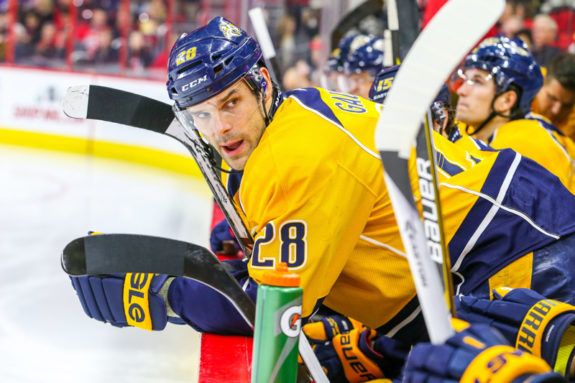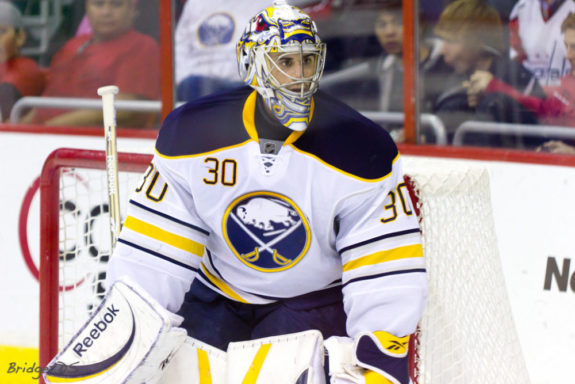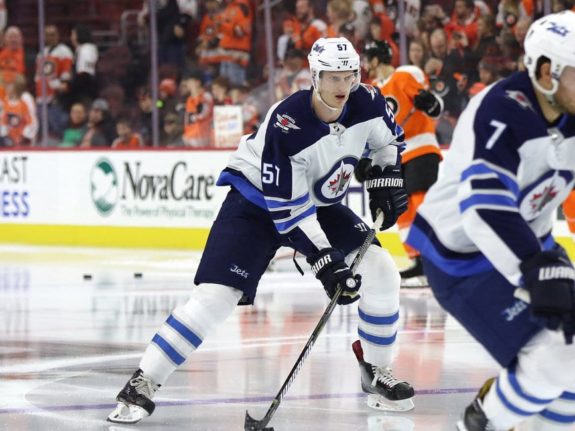The April 12 trade deadline is getting closer by the hour, and the Buffalo Sabres figure to be among the busier teams in the NHL in the coming days. While a five-game point streak has provided a small dose of optimism, the Sabres still sit at 31st in the NHL by a comfortable margin with a 9-23-6 record (24 points).
With seemingly half the roster involved in trade rumours — from sure bets like Taylor Hall and Brandon Montour to long shots like Rasmus Ristolainen and Linus Ullmark — general manager Kevyn Adams has a lot of big decisions to make.
Sabres fans should hope that he fares better than some of his predecessors. One of the many factors that has contributed to the franchise’s decade of futility is the failure of the many GMs to make smart trades.
Hindsight is obviously 20/20 when it comes to any trade. With that said, here is how the Sabres fared with some of their biggest deadline moves of the last decade (this list does not include offseason deals such as the Ryan O’Reilly and Jeff Skinner trades).
Paul Gaustad, 4th Round Pick to Nashville for 1st Round Pick (Feb. 27, 2012)
Yes, you read that right: the Sabres once got a first-round pick for third-line center Paul Gaustad. “The Goose” had become a fan favorite in Buffalo, but GM Darcy Regier couldn’t pass up the opportunity to snag a first-rounder in return.
Gaustad did very little with the Predators, scoring just 50 points in 240 games in a bottom-six role. Seeing that, you might think that this trade was a steal for the Sabres.

The problem was that fourth-rounder that was essentially a throw-in eventually turned into goaltender Juuse Saros. While the Finnish netminder might not be considered one of the league’s elite, he obviously became a tremendous value as the 99th overall pick.
As for the first-rounder Buffalo received, the team eventually used it to trade up in the 2012 Draft to select Zemgus Girgensons. Ironically, Girgensons became a very similar player to Gaustad: a big, hard-working forward who provided little offensive value. He’s lasted quite a long time in Buffalo, but his career has not been one you’d expect out of a top-15 pick.
Nobody could have envisioned a fourth-round pick turning into a legitimate starting goaltender, but that doesn’t prevent the Predators emerging as the clear winners in this transaction.
Grade: C
Ryan Miller, Steve Ott to St. Louis for Chris Stewart, William Carrier, Jaroslav Halak, 1st Round Pick, 3rd Round Pick (Feb. 28, 2014)
This was the deal that signaled that “the tank” was well and truly underway. The first of a flurry of deadline moves made by new GM Tim Murray in the 2013-14 season, the Sabres shipped out the face of the franchise (Miller) and the team captain (Ott).
But for such a momentous deal at a critical juncture for the franchise, this trade turned out to be mostly a wash for both sides.
Miller only ended up playing in 19 regular season and six playoff games for the Blues, while Ott finished with just 17 points in 122 games in St. Louis.

As for the Sabres’ return, it was similarly underwhelming. Halak was immediately flipped to Washington in a trade that brought them Michal Neuvirth. Stewart scored 25 points in 66 games as a Sabre before being sent to Minnesota for a second-rounder that became goalie prospect Ukko-Pekka Luukkonen. Carrier scored eight points in 41 games before being selected by Vegas in the expansion draft.
The first-rounder Buffalo received was used in another trade that we’ll get to shortly. The third-rounder, meanwhile, became a part of the Dmitry Kulikov-Mark Pysyk deal with Florida in 2016.
All in all, this trade was a lot of sound and fury, signifying not much of anything.
Grade: B-
Joel Armia, Tyler Myers, Drew Stafford, Brendan Lemieux, 1st Round Pick to Winnipeg for Zach Bogosian, Evander Kane, Jason Kasdorf (Feb. 11, 2015)
This trade was a genuine jaw-dropper, a legitimate blockbuster involving eight players, including multiple big names and a high draft pick. It’s the kind of deal you just don’t see much of in the NHL anymore.
But like the previous deal, there is no definite winner or loser. With the tank fully underway, Murray was once again looking to shake up the roster, and boy did he ever. The GM shipped out one of the team’s best goalscorers (Stafford), a former Calder Trophy winner (Myers), two promising prospects (Armia, Lemieux), and a first-rounder (the one acquired in the aforementioned St. Louis trade). In return, he received two former top-five picks just entering their primes (Bogosian, Kane) and an intriguing goalie prospect (Kasdorf).

Looking at what each player did with their new teams, you’ll see that Winnipeg got more quantity while Buffalo got slightly better quality. Armia, Myers, Stafford, Lemieux, and the first-rounder — which became forward Jack Roslovic — totaled 321 points in 826 games as Jets (0.39 points per game). Bogosian and Kane, meanwhile, totaled 185 points in 439 games during their stays in Buffalo (0.42 points per game).
Neither player, however, turned into the cornerstones that the franchise was looking to build around. Kane scored 20-plus goals in each of his three full seasons, but never scored 30. Bogosian, meanwhile, simply couldn’t stay healthy, never appearing in more than 65 games in a single season.
The deal didn’t turn into a disaster for the Sabres, but it was far from a success.
Grade: C+
Evander Kane to San Jose for Danny O’Regan, Conditional 1st Round Pick, Conditional 4th Round Pick (Feb. 26, 2018)
With another season going down the drain en route to earning the first overall pick, the Sabres were in rebuild mode once again in 2017-18, this time under the leadership of Jason Botterill.
Still just 26 years old and in the midst of his fourth-straight 20-goal season, Kane was seen as one of the big prizes of the 2018 Trade Deadline. A San Jose squad that was still in its window of contention was looking to boost its offense and came up with the most enticing offer.
The key to the deal was the conditional first-rounder. If the Sharks missed the playoffs in 2019, they could retain their first-rounder that year, in which case Buffalo would receive San Jose’s 2020 first-rounder. The Sharks ended up making the playoffs comfortably and re-signed Kane, meaning the Sabres received their 2019 first-rounder.
Unfortunately, the Sabres ended up coming out on the losing end of this deal as well. O’Regan appeared in a grand total of three games as a Sabre, the first-rounder was eventually used to acquire Montour (see below), and the fourth-rounder was sent to Vancouver in what amounted to a pick swap.
Kane, meanwhile, has scored 150 points in 194 games in San Jose; his 0.77 points per game there is comfortably ahead of his totals with the Jets/Thrashers (0.61) and Sabres (0.60). He’s been the center of plenty of off-ice drama — he filed for bankruptcy in January, and there are reports that San Jose could void his contract — but he’s still a consistent contributor on the ice.
Moving Kane was probably the right move at the time, but the return was nowhere near good enough.
Grade: C-
Brendan Guhle, Conditional 1st Round Pick to Anaheim for Brandon Montour (Feb. 24, 2019)
This is a difficult trade to grade. There are caveats attached to each piece of the deal. Guhle was considered one of the Sabres’ top blue line prospects — but he has just nine points in 36 games for the Ducks. The Sabres gave up the first-round pick they acquired in the Kane trade — but Anaheim was only able to turn it into forward Brayden Tracey, currently viewed as a mid-level prospect. Montour was seen as a dynamic addition to Buffalo’s blue line — but his points per game with the Sabres (0.37) is identical to that of his with Anaheim.
Montour’s strong play in recent games has helped boost his value in anticipation of a likely trade, but it still speaks poorly of the Sabres’ management that a player they gave up a first-round pick and a good prospect for lasted less than three full seasons.
Grade: C+
Clearly, the Sabres’ recent history of big trade deadline deals is less than stellar. If Adams and company have any hope of turning things around, the moves made in the coming days need to net much bigger returns than those made in the last decade.